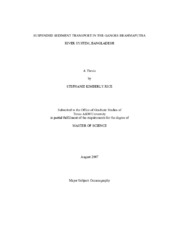| dc.description.abstract | An examination of suspended sediment concentrations throughout the Ganges-Brahmaputra River System was conducted to assess the spatial variability of river sediment in the world’s largest sediment dispersal system. During the high-discharge monsoon season, suspended sediment concentrations vary widely throughout different geomorphological classes of rivers (main river channels, tributaries, and distributaries). An analysis of the sediment loads in these classes indicates that 7% of the suspended load in the system is diverted from the Ganges and Ganges-Brahmaputra rivers into southern distributaries. Suspended sediment concentrations are also used to calculate annual suspended sediment loads of the main river channels. These calculations show that the Ganges carries 262 million tons/year and the Brahmaputra carries 387 million tons/year. These calculations are lower than published values because of either interannual variability and/or sampling artifacts and assumptions in the homogeneity of flow and sediment concentration. The conjoined Ganges-Brahmaputra River carries 530 million tons annually, or only 80% of the sum of the loads that the Ganges and Brahmaputra rivers carry upstream of the confluence. The remaining 20% of sediment is diverted from the main river by the distributaries and deposited along the main river channel during overbank flooding. Suspended sediment concentration is also examined in the north-south oriented tidal channels on the Bay of Bengal to determine whether sediment is delivered to the channels by one of two pathways: (1) sediment is discharged into the Bay of Bengal by the main river channel, carried west by coastal currents, and advected northward into the channels by tidal currents or (2) diverted from the main river bed through the distributaries, migrating southward into the tidal channels. Suspended sediment concentration and salinity data are inconclusive in determining sediment source. Beryllium-7 radioisotope data indicate that newly transported sediment is present in the tidal channels and offshore despite values in the Ganges and Ganges-Brahmaputra rivers being below detection. Sampling artifacts are likely caused by the below detection readings in the Ganges and Ganges-Brahmaputra rivers. Newly transported sediment is observed in a distributary south of the Ganges River and indicates that sediment is actively being transported to the distributary region. | en |


